This is the continuation of our post from last week, in which we interviewed Paloma Dawkins: game designer, animator, and TAG’s superstar artist in residence.
In Part 2, Paloma talks about going to GDC (Game Developer’s Conference), writing graphic novels, and what she has planned for the future

GDC badge, artistically modified and photographed by Paloma. Borrowed from her Twitter: pic.twitter.com/KBjilbZMF6
Q. What did you see at GDC that was the one really amazing thing?
Every year I go to GDC, I really like the experimental games workshop. I find that to be a great source of information and inspiration for what is the cutting edge of the art of gaming. And I saw a project that was being done with the Vive… it was called Fantastic Contraption, I think. You have to pick these pieces and make this machine that runs, and turns on a thing, and it’s super cool.
I also saw something called Dreams, which was a part of the Day Of The Devs exhibit. It was so cool. It’s also a Vive project. It’s not very well known, I guess. I’ve just never heard of it before. It’s called Dreams and it’s kind of like you create these characters, and you create a scene, and you can make it pretty much anything. It’s super creative. And then you can make these characters… you can change how they look and you can give them lines, you can give them actions, so you can create an entire scene, that’s walkable. It’s basically like level creation. You can make a game using this. It must be super cool to use. They weren’t really demoing it though. They were just showing it. Some guy was playing it. You weren’t able to play it. I guess it’s too difficult to use. But it looked amazing.
Q. Would you want to do a VR project at some point?
Yeah I do. I really do, like, now I do. It’s a thing. I learned about the possibilities and it’s really cool. It looks really exciting.
Q. Anything else you’re working on?
I’m working on a few things. I also work on some graphic novels. I have one that’s being published soon, and I’m working on another one, a graphic novel about my last game. And there’s various other collaborative projects that I’m working on.
Q. Can you tell me about the graphic novels?
Yeah. One of them is called Summerland, and it’s gonna be published… actually the Kickstarter I think finishes on Friday [Editor’s note: April 15, 2016]. So hopefully it will work out. It’s just a graphic novel about a young girl… she is putting on plays, and then the graphic novel takes place half in the past and half in the future, and it just shows how these people in the play grew up and changed.
The other one, it’s a graphic novel about Gardenarium, which is this other game that I made, and the game was just littered with these six characters that have…. They would just talk about their problems, and so this comic is going talk about what happened after the game, basically.
Sneak peak at the Gardenarium comic, which is making its debut at TCAF 🌾🌿🍄🌴🌳 pic.twitter.com/wfncyNi3WQ
— PALGAL @Indiecade@ (@Palomadawkins) April 23, 2016
Q. What’s the next thing for you?
I’m still going to work more on those graphic novels. I mentioned before, I have a couple collaboration projects. And I’m also working on Gardenarium 2. I think that the idea of sequel games is kind of funny. I planned these six gardens, when I originally made the game, but I only had time to do one, the Cloud Garden, so I figured I should just do the other ones too. Because that’d be fun.
Q. So, part of your original plan, but now you’re making it a sequel.
Yeah, exactly.
Q. Do you planning on changing how it looks or how it works, or more like just another level?
I want it to be the same theme, where there’s a place that everyone tells you you’re not supposed to go. There’s that, and there’s also the perspective change, so you’re walking around in this little island thing and then you float up above, you do a mini game, and then you float back down. All of these characters are telling you that you can’t reach this destination. And then your goal in the game is to reach that destination.
Q. So kind of like noticing when someone tells you that there’s something you can’t do, and then doing it [Editor’s note: this was part of the advice she had for indie designers in the first part of the interview]
Yeah! And there’s these weird collectibles.
Sequels… you find the concept weird?
I think it’s funny. I mean, when do people do sequels? I just feel like people do sequels whenever they want to make an extra buck on it. But for me, I just want to do it to just expand on that original concept. It’d be cool to keep jiving on that original success. I think it’d be realy cool… what happens if you just pull more out of it? I think it can keep it fresh because it’s such an open idea. The concept of Gardenarium just totally exploded. It was just all improvised. So I can just keep improvising and making these games that are diverse, but based on the same idea.
Check out Paloma’s work at http://www.palomadawkins.ca/
